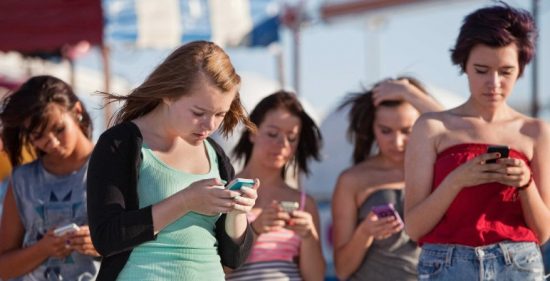August 17, 2017 – “Behind a computer screen, the lonely person has control. But the contact this produces is not the same thing as intimacy.” So states Olivia Laing in an article she published in The Guardian back in 2015. Her observation was spot on. That’s why I wanted to write about what I have observed in my daily existence that I find perplexing and disturbing. For when I walk down the street where my wife and I live, I see young and old carrying smartphones in hand, head down and eyes affixed on their small screens. Many times as that person approaches I feel I need to be wearing a bicycle horn so that I can alert them to my approach. I observe similar behaviour on buses, streetcars, and subways. People are immersed within their devices and apps, with earbuds blocking the sounds of the world around them, and it would seem cut off from the world around them and any meaningful interaction with other humans, or even their pets.
As much as Facebook, Twitter, Pinterest, Instagram and other social media apps draw us to our in-hand technology, they represent a descent from human contact to total isolation.
We are connected by these apps and Google to a virtual space and less connected to each other. People text rather than call and talk. They even text when sitting in the same room, or from across the aisle while riding on a bus. This has become the new norm.
That isolation by the rise of virtual space may be one of the main reasons for the demise of department stores and other bricks and mortar retail. With the likes of Amazon and online others, consumers no longer have to engage sellers in a point-of-sale physical space. Online ordering and home delivery provide such convenience that you may connect through virtual space to have anything you want including the food you eat. And each time you interact with that virtual world the patterns of your requests, searches, purchases, and words, get parsed by intelligent algorithms which compile a profile to feed you further temptations, getting you to visit another site or buy another thing. Then there is video gaming, mostly performed by an individual, alone in a room, or alone in a crowded subway car. It doesn’t seem to matter.
It is insidious, addictive, and all consuming. You, the user are hooked to a world where isolation delivers rewards.
Social media asks you to friend people. I know that I have 342 friends on Facebook. But the real number of friends is probably one-tenth of that.
My 21cen Facebook page is approaching 700 followers and likes. Are these people really followers? How many do I actually get the opportunity for interaction beyond the virtual?
On Twitter I have almost 500 followers and follow 200 myself. I know maybe 10 of these people well enough to phone them and talk.
On LinkedIn, I have 1,425 connections. As much as this number gives me some comfort, these professional connections are tenuous at best.
And if I attempted to physically meet with the thousands that “know” me through these social media spaces I would soon run out of money traversing the planet, and when I met them, most would ask “who are you?”
There is a phrase “living within the bubble.” It refers to the precarious conditions of existence for those of us born with no natural immunity. Hence they live in a bubble, a membrane that forms a barrier to the outside world with filters purifying the air the person breathes so that no germs interact with them.
The phrase more recently has been associated with politicians who toe the party line, “living within a bubble.”
The bubble that virtual technology creates is cognitive. It captures a mind and isolates it. Interactions tend to be with those who are like-minded and as fixated on the virtual space. With less exposure to real people in a physical world, the bubble effectively cuts you off from new ideas and interactions. You remain isolated within a shared comfort zone.
That is not who we are as a species. Humans evolved from arboreal primates who first lived in small social groups. In our journey, we left the trees, connected beyond family units, formed tribes, then villages, towns, cities, and nations. We even created organizational bodies that encompassed the entire planet. But our 21st-century technology, which gives us the means to touch every human through the interconnectivity of the Internet, has also isolated us within a crowd.
As I have written here before, the skills we need to thrive in the 21st century and beyond focus on adaptability, interpersonal communication, hobbies and interests, and escaping from the trap and confines of virtual space. After reading this on whatever device you have in hand or in front of you, I advise you to switch it off, turn to the people around you and engage them in conversation. Go to a library and take out a physical book. Find new things to do that don’t involve video screens. And for your next shopping outing, walk to a real bricks and mortar store and interact with a salesperson. I guarantee you that the experiences derived will pay dividends every day.









